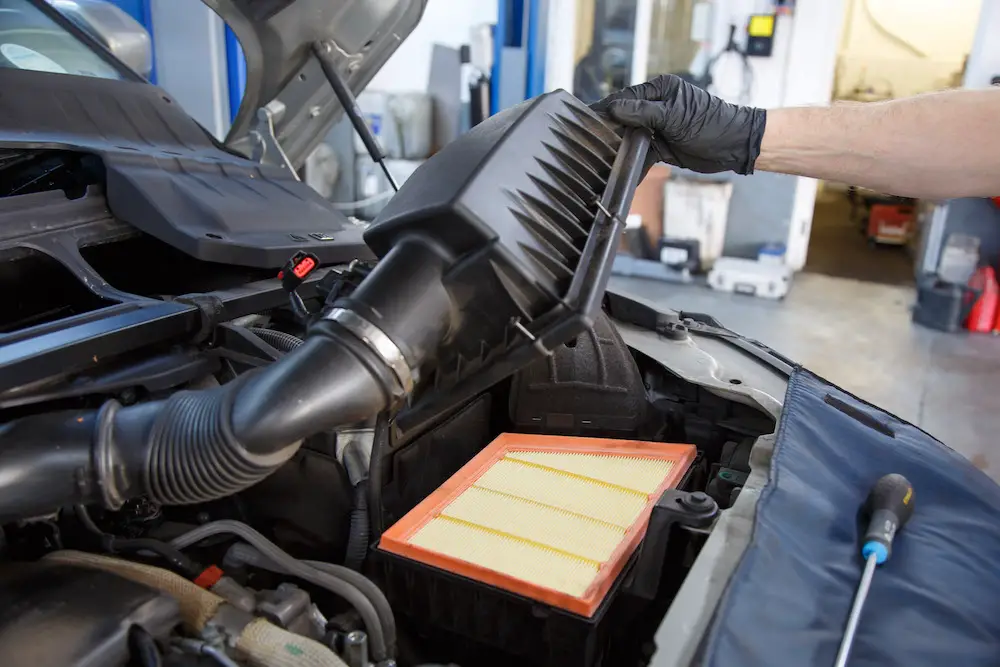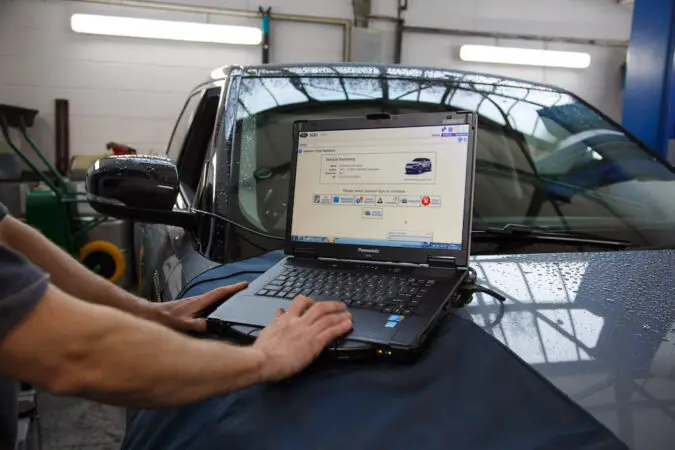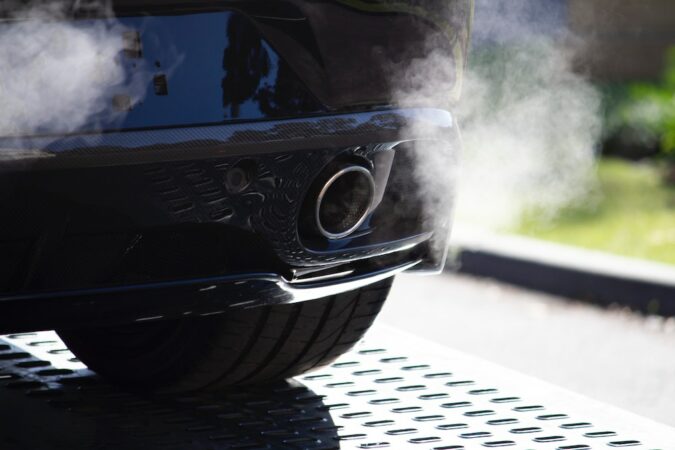To ensure well-optimized combustion, your engine is reliant on data from a vast network of sensors and electronics to constantly provide real-time feedback. Whether it’s input on air pressure, amount of fuel being pumped into the engine, ignition timing, position of the camshaft and crankshaft, and much more. When one or more of them fail or provide erratic readings, errors like P0113 pop-up.
Among those measurements that are crucial for the engine’s ECU (its central command module which manages the entire powertrain) is the temperature of the oncoming air. Quite surprisingly, how hot or cold is the oxygen that’s surging into the engine can make a huge difference. Hotter or colder air determines the actual oxygen (O2) content and its concentration, affecting performance and MPG.
As such, your car will gauge this using an ‘intake air temperature’ (or IAT) sensor. With that data on hand, your ECU would carefully manage the engine to run as powerful as it can be, without burning away too much fuel. Or, impact driveability. But what if the IAT sensor fails? If and when that occurs in your car, a P0113 diagnostics code appears when diagnosed. So, what does a P0113 code mean?
What Is An Intake Air Temperature (IAT) Sensor?
Before looking at P0113, we should first understand what its related component does. So, what can an ‘intake air temperature’ (IAT) sensor do, anyway? In short, and as we briefly explained earlier, an IAT sensor monitors the temperature of the air rushing through the intakes and into the engine. It’ll then report this temperature info back to the ECU (or PCM, or ECM, depending on your vehicle).
As we all know, an internal combustion engine requires two key elements to combust – air and fuel. In the real world, the actual temperature of the air doesn’t matter as much in this regard. Rather, it only matters for how much oxygen they contain. Moreover, the nature of hotter or colder air could also significantly impact their density, requiring a varying amount of fuel to ignite it with:
- Cold Air – Denser than hot air, with greater availability of oxygen (O2). Colder air needs more fuel to burn it evenly and maintain an ideal air-to-fuel ratio.
- Hot Air – Less dense than cold air, with lesser availability of oxygen (O2). Hot air needs less fuel to burn it evenly and maintain an ideal air-to-fuel ratio.
With these two conditions in mind, we can thus extrapolate how they impact your car’s driveability. At lower air temperatures, you can expect better performance and torque. It’s due to how minimal the oxygen content is in hotter air. As the ECU is balancing the engine’s air-to-fuel ratio, hotter air prompts it to pump less fuel into the engine. Thus, increasing MPG, but your performance suffers.
Where Can You Find The IAT Sensor?
Remember, an engine will try to maintain its air-to-fuel ratio close to an optimal stoichiometric ratio of 14.7:1 to ensure thorough combustion. In other words, that’s 14.7 parts (or gram) of air for every 1 part (or gram) of fuel. If there’s less oxygen in the engine (as is the case with hot air), the ECU will pump less fuel to balance it out. That’s simply because it doesn’t require as much fuel for a burn.
That oxygen density and air temperature are measured by the IAT sensor. So, how would an intake air temperature (IAT) sensor work? For starters, you can usually find the IAT sensor mounted within the intake manifolds. In some vehicles, an IAT sensor might be enclosed within a single module with the MAF (mass airflow, which calculates the volume and airflow rate) sensor, built into the housing.
On others, you’ll find the IAT sensor as part of a MAP (manifold absolute pressure, which measures air and vacuum pressure) sensor. Note, some engines may have more than one IAT sensor. This can be true of engines where the intake manifolds are split or separate from one another. For example, high-performance V8 or V6 engines. They can feature one IAT sensor for each manifold if needed.
In any case, the IAT sensor will always be located on or near the intakes (you can find out more in our diagnosis explainer on the P0113 Jeep code), exposed to fresh air rushing into the engine. Just for a spot of context, the IAT sensor could go by many names. This is the case if you have an older car, or depending on the make and model:
- Air Change Temperature (ACT) Sensor
- Vane Air Temperature (VAT) Sensor
- Manifold Charging Temperature (MCT) Sensor
- Manifold Air Temperature (MAT) Sensor
- Charge Temperature Sensor (CTS)
How Does An IAT Sensor Work?
So, how does this IAT sensor work, then? Inside, and kept exposed to oncoming air, the tip of the IAT sensor is a thermistor. Therefore, it measures (and thus provides feedback to the ECU) temperature by changing electrical resistance accordingly. There are two types of IAT (intake air temperature) sensors that are commonly used in most cars:
- Negative Temperature Coefficient (NTC) – They have high electrical resistance when it’s cold, but it’ll start dropping once the air gets hotter.
- Positive Temperature Coefficient (PTC) – They have low electrical resistance when it’s cold, but it’ll start increasing once the air gets hotter.
It starts when the ECU (or ECM or PCM) sends a reference voltage to the IAT sensor. This is generally around 5 or so volts. Depending on the resistance (as air temperature changes), the voltage reading will circle back to the ECU either as a higher or lower figure. Subsequently, the ECU analyses the air temperature and O2 density, purely through the resistance emitted in the IAT sensor.
In most modern vehicles, an IAT sensor isn’t only used for the engine’s combustion cycle. Instead, a car today might feature up to three IAT sensors at a time. One of which (at least) is dedicated to the engine, as we’ve explained already. Meanwhile, there are two others, placed around the car:
- One for measuring ambient air temperature outside the vehicle, usually for climate control. Or, just to show you how hot it is outside. You can find this sensor behind the grille, or tucked near the windshield.
- Another for measuring air temperature inside the vehicle, also for the climate control. They usually work using infrared to measure your body temperature (and that of the other occupants), to adjust heating or cooling as required.
How Does An IAT Voltage Output Look Like?
We can summarise by concluding that with colder air, your IAT sensor’s resistance value will be high. Alternatively, with hotter air, your IAT sensor’s resistance value will be lower. When the ECU reads this air temperature and oxygen density data, it’ll consequently affect how much fuel is injected into the engine. With cold air, the fuel injectors open for longer, letting more fuel in, or vice versa for hot air.
So, what do those readings from the IAT sensor look like? Well, this table should be a good reference point for diagnosis and testing (more on that later), albeit your readings may vary slightly:
| Temperature (°C) | Temperature (°F) | Voltage (V) | Resistance (Kilo Ohm) |
| 10 | 50 | 3.52 | 58.75 |
| 20 | 68 | 3.06 | 37.30 |
| 30 | 86 | 2.62 | 24.27 |
| 40 | 104 | 2.16 | 16.15 |
| 50 | 122 | 1.72 | 10.97 |
| 60 | 140 | 1.35 | 7.60 |
| 70 | 158 | 1.04 | 5.37 |
| 80 | 176 | 0.80 | 3.84 |
| 90 | 194 | 0.61 | 2.80 |
| 100 | 212 | 0.47 | 2.07 |
| 110 | 230 | 0.36 | 1.55 |
| 120 | 548 | 0.28 | 1.18 |
As we can see, lower temperatures have higher resistance and thus higher voltage. On the flip side, higher temperatures have lower resistance, which leads to lower voltage. Once again, vehicle make and model-specific IAT sensors will have varying readings for voltage and resistance. It’s a good idea to refer to your car’s owner’s or service manual to find precise readings for its IAT sensors.
On another note, you may also observe how under ordinary air temperatures in the intakes, voltage readings will always stay below the 5V reference sent out by the ECU. If the feedback voltage that’s received by the ECU from the IAT sensor is at or higher than 5V, it could mean two things. Either the air temperature is too hot, or the IAT sensor is malfunctioning and is sending back incorrect readings.
What Does A P0113 Error Code Mean?
If either of those aforementioned scenarios happens, a P0113 error code will be triggered. So, what does it mean? An accompanying error message might read something along the lines of “Intake Air Temperature Sensor 1 Circuit High Input”. That’s another way of saying that the voltage reading is high, or far higher than the 5V that an IAT sensor’s electrical resistance should normally minimize.
At most, an IAT sensor should send back 4.6V at most to the ECU. This is roughly equivalent to the IAT sensor reading -40°C (it’s the same in Fahrenheit °F as it is in Celsius with negative values). On the other hand, the term “sensor 1” tells you that it’s one of two or more IAT sensors that’s failed. When taken as a whole, P0113 means that IAT Sensor 1 is reading erratically or is off the charts.
P0113 might be triggered if the resistance is too low, or in other words, the air temperature in the intakes is too hot. However, it should be noted that temperature (too hot) alone won’t influence the resistance and voltage readings. It could be caused by a faulty, dirty, or clogged IAT sensor. Besides P0113, you should be on the lookout for other IAT sensor-related error codes, such as:
- P0095 – Intake Air Temperature Sensor 2 Circuit Malfunction
- P0096 – Intake Air Temperature Sensor 2 Circuit Range/Performance
- P0097 – Intake Air Temperature Sensor 2 Circuit Low Input
- P0098 – Intake Air Temperature Sensor 2 Circuit High Input
- P0099 – Intake Air Temperature Sensor 2 Circuit Intermittent/Erratic
- P0110 – Intake Air Temperature Sensor 1 Circuit Malfunction
- P0111 – Intake Air Temperature Sensor 1 Circuit Range/Performance
- P0112 – Intake Air Temperature Sensor 1 Circuit Low Input
- P0114 – Intake Air Temperature Sensor 1 Circuit Intermittent/Erratic
What Causes A P0113 Error Code?
Even if you’re driving through the hottest deserts in the world, it’s not hot enough to heat up an IAT sensor to a point where it’ll trigger a P0113 error code. Although hot air, caused by heat radiating in the engine, could trigger P0113, the most likely culprit are mechanical and electrical issues. It might stem from the intake air temperature sensor itself, or other problems elsewhere. They include:
- Loose, disconnected, bad, damaged, or frayed wiring connecting the IAT sensor circuit to the ECU.
- Corrosion and visible damage or wear on the pins and connectors around the IAT sensor.
- Short-circuit or being stuck in an open-circuit within the IAT sensor’s circuitry. This applies to either the signal circuit reporting back to the ECU or the original reference 5V circuit leading to the IAT sensor.
- IAT sensor’s wiring is routed too close to other high-voltage wires and components (e.g. spark plugs, alternator, etc.), which might cause electromagnetic fields to skew the voltage readings.
- Clogged and dirty IAT sensor, from debris or oil contamination getting into the intakes. Oil may get into the intake system through your car’s positive crankcase ventilation (PCV) system.
- Internal faults with the thermistor and measuring elements of the IAT sensor, which can falsely read the air temperature.
- Dirty or clogged air filter, hindering airflow leading into the engine and IAT sensor. This forces your intake system to work harder, which could increase intake air temperature.
- Bad MAF (mass air flow) sensor, which could force more air into the engine than necessary. Doing so could overheat the intake system, leading to higher intake air temperature.
- Glitchy ECU (or ECM or PCM) that needs reprogramming or a software update (this is rare, but it’s still possible).
What Are The Symptoms That Accompany P0113?
A P0113 error code is among the more subtle problems for your car to experience. As such, it can be quite challenging to notice or pinpoint tell-tale symptoms. However, given time, a faulty IAT sensor will start to exhibit clear-cut signs of failure. Without informing the ECU on the density of oxygen in the air, it’ll likely result in an imbalanced air-to-fuel ratio, affecting driveability and performance:
- Check engine light (CEL) illuminates in your dash, as it’s storing the P0113 code for later analysis, as well as letting you know that something’s amiss.
- Difficulty starting your car, especially in colder weather. With an imbalanced air-to-fuel ratio, not to mention possibly overheating the intake system, it’ll make it harder for the engine to crank.
- Higher fuel consumption, which will begin to worsen over time. Once again, a bad IAT sensor would fail to inform the ECU of the air composition. As a result, the ECU is unable to manage the air-to-fuel ratio properly, possibly dumping more fuel into the engine than is required.
- Loss of power and hesitation while accelerating. This time around, your ECU’s inability to control the air-to-fuel ratio leads to not enough fuel being pumped into the engine.
- Misfiring in one or more cylinders. Without the right mixture of fuel and air, incomplete combustion will occur.
- Rough idling and fluctuating RPMs (engine speed). Your car will feel and sound rougher, especially in colder weather. There’s also a higher risk that your engine might stall out while idling or driving.
- Failed emissions testing. If your engine is running rich (too much fuel, not enough air), unburnt fuel will be exhausted out of the tailpipes. Not only would you notice thick, black, and sooty plumes of smoke, the heightened pollution would fail your emissions test.
How Can You Diagnose (And Fix?) A P0113 Error Code?
Once you’ve figured out that you have a problematic IAT sensor, courtesy of a P0113 error code, you could now begin solving it with a thorough diagnosis. This helps us to narrow down the root cause of the issue at hand and would expedite the process of solving it. Mostly, P0113 (a faulty IAT sensor) is hardly considered to be a serious issue. Therefore, it doesn’t necessitate urgent repairs to be made.
There isn’t an immediate threat to your car. Nor, though this will depend on how advanced the issue is, would it leave a substantial impact on your car’s functionality. However, know that even a trivial problem, if left unresolved for long, can develop into serious concerns down the line. This is the case with P0113, and leaving a malfunctioning IAT sensor be for long isn’t a good idea.
If the engine’s intake system is getting a bit too toasty. Or, if there’s another fault elsewhere with a MAF sensor or the IAT sensor’s electrics, the ECU will continue to be devoid of feedback with the air-to-fuel ratio. Ignore this, and running your engine too lean or rich for long can leave scarring as well as permanent internal damage within the engine. So, a prompt trip to the workshop is advised.
Step 1: See If There Are Any Other Error Codes Besides P0113
To start off, let’s make sure that P0113 or any other IAT sensor-related diagnostic codes (just as we listed earlier) are the only ones that you’re seeing. If you’ve spotted a different error code that could explain why your engine’s air-to-fuel ratio isn’t ideal, then diagnose those ones first.
Grab an OBDII diagnostics tool, and check for each error code. Once those are all done, you can try clearing the ECU of all error codes, and give your car a test drive. If the check engine light reappears with a P0113 code (or other IAT sensor code), you can start diagnosing the IAT sensor.
And since you have the OBD scanner on hand, pay close attention to the live data feed from the IAT sensor. Try to locate the IAT sensor, and disconnect it while the OBD’s plugged in. Does the live feed immediately jump down to -40°F? If so, then the sensor, its circuit, or the wiring is shorted.
Step 2: Make A Visual And Thermal Inspection
With the OBD scanner out of the way, let’s take a closer look at the IAT sensor. We can first start by inspecting the sensor visually, paying close attention to the wires, connectors, and pins that lead to and away from the IAT sensor. Electrical issues are the most common causes of failure with these.
Next up, we can proceed with getting a temperature reading:
- Start your engine, and let the engine idle until it’s warmed up.
- Get yourself an infrared thermometer.
- Then, point the thermometer at the engine coolant (or antifreeze) and the IAT sensor. For the latter, you could instead refer to your OBD tool’s intake air temperature live feed.
- Now, compare the temperature readings. If they’re the same (roughly similar, or if the intake air is slightly hotter), then the IAT sensor is working just fine. But, if the intake air is shown to read cooler than your coolant temperature, the sensor might be faulty.
- Before we can conclude that, however, double-check all the wiring and connectors around the IAT sensor once more. In addition, you can begin a visual inspection of the air filter and intake system. If it’s dirty, clogged up, or is soaking in oil, you should clean or replace those first.
Step 3: Checking The IAT Sensor’s Resistance Output
Last but not least, we can confirm the IAT sensor’s condition with a quick resistance check:
- Disconnect the IAT sensor from its mounting, and grab a multimeter (ensuring that you’ve set it to the ohm/resistance scale).
- At room temperature, measure the resistance through the IAT sensor.
- Next, you can get a hairdryer to apply heat to the thermistor tip of the IAT sensor.
- With heat, the resistance readings from the IAT sensor should decrease.
- If the resistance hasn’t changed or if it’s infinite (showing up as OL in the multimeter), it means that the IAT sensor has gone bad.
Should all the diagnoses so far point towards there being a fault with the IAT sensor, you then have two options. The first would be to clean the sensor. You can either use a special MAF (mass air flow) sensor cleaner, or an electronic parts cleaner. Both work wonders in washing the IAT sensor clean.
This is great if the sensor hasn’t broken. But, if it’s merely clogged, dirty, or has been contaminated with oils or other debris. It’s a quick, cheap fix. Otherwise, and if the IAT sensor has failed for good, then you’ll have to replace it outright. On average, the total replacement cost is around $40 to $250.
That accounts for both labor and parts. For parts alone, you could easily find an IAT sensor for as little as $20, or upwards of $150 for higher-end units. Labour (if you’re not doing it DIY) isn’t costly either, for another $20 to $100. Often, the IAT sensor is easily accessible and effortless to replace.
Facts About Error Code P0113 and its Symptoms, Causes, and Diagnosis
- Error code P0113 is an extension of the OBD II code P0, which signifies a problem with fuel and air metering.
- P0113 indicates an issue with the vehicle’s intake air temperature sensor, which measures the temperature using a thermistor.
- The drop in resistance on the thermistor equates to a rise in temperature, and the error code signifies a decrease in resistance.
- Symptoms of a P0113 code include a car that is unable or hesitant to start, increased fuel consumption, and misfires.
- The most common causes of a P0113 code include issues with IAT or MAF sensors, a dirty air filter, damaged or corroded wiring, and a faulty PCM.
- P0113 is considered a minor issue, but if not addressed promptly, it can result in more serious problems such as misfires.
- Other codes similar to P0113 may appear in tandem with it, making the root cause more challenging to diagnose.
- It is recommended to seek the aid of a professional mechanic for diagnosis, especially for P0113 since it often comes with other codes.
- Inspection and repair of the IAT sensor, air filter, MAF sensor, or PCM require complex processes that should be left to experienced mechanics.
- Codes ranging from P0110-P0114 all warrant similar symptoms and causes, making it crucial to diagnose the root cause of their display.
Final Thoughts On A P0113 Error Code
That should round up our look at a P0113 error code, detailing problematic readings with your IAT sensor. In all, it’s not as serious or as catastrophic as other car issues. It won’t destroy your engine right away, but leaving it be for too long will no doubt scar it. Therefore, a prompt fix is advised, as you’re left with a car that isn’t running right, not to mention consuming a lot of fuel.
It’s not a gravely expensive part to replace, either. IAT sensors are among the cheaper ones to fix or replace altogether. Although, you have to bear in mind that IAT sensors, in some cars, are built into the MAF sensor. Replacing one of those will cost you closer to $500, so be wary. With that said, it’s well worth the price to ensure that your engine runs smoothly, efficiently, and without difficulty.





